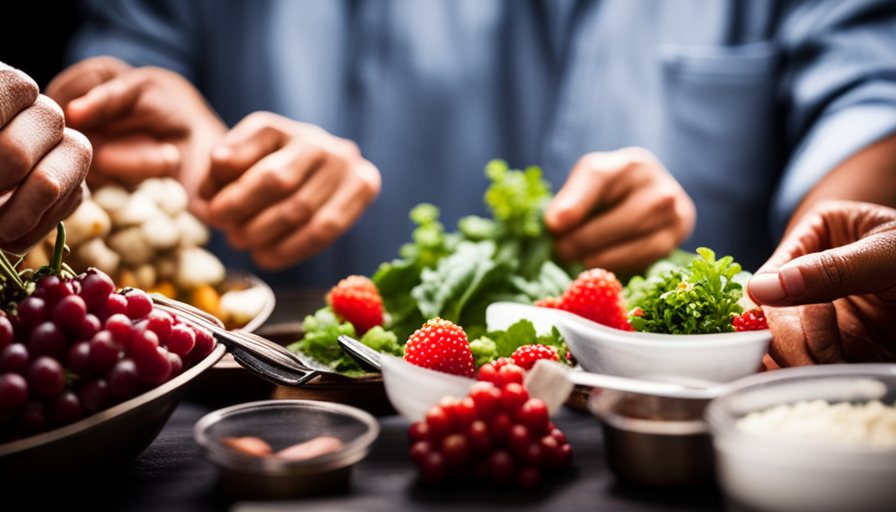Are you someone who kicks off each day as a fitness enthusiast with a protein shake?
Picture this: Joe, a dedicated gym-goer, diligently blends his daily protein shake, adding a touch of adventure by including raw eggs. Little does he know, this seemingly harmless practice puts him at risk for a potential food-borne illness.
Raw eggs, although a source of protein, may harbor dangerous bacteria that can lead to infections. One such bacteria is Salmonella, a common culprit found in raw eggs. Infected individuals may experience symptoms like nausea, vomiting, and diarrhea, with severe cases leading to hospitalization.
To protect yourself from these risks, it’s crucial to understand proper food handling and preparation techniques. Additionally, there are alternatives to raw eggs that can provide the same protein benefits without the potential dangers.
By prioritizing hygiene in the kitchen and educating others on the risks, you can ensure a healthy and safe protein shake routine.
So, let’s dive into the dangers of consuming raw eggs and the importance of making informed choices for a nourishing lifestyle.
Key Takeaways
- Consuming raw eggs in protein shakes can put Joe at risk for food-borne illnesses.
- The main concern is the risk of Salmonella infection, as raw eggs may contain harmful bacteria like Salmonella.
- Cooking eggs thoroughly to an internal temperature of 160°F (71°C) can effectively kill bacteria and reduce the risk of illness.
- To minimize the risk of cross-contamination and the spread of pathogens, proper hygiene and food handling techniques should be followed, including storing raw meat separately, using separate cutting boards and utensils for raw meat, washing hands before and after handling raw meat, and regularly cleaning and sanitizing surfaces and countertops.
The Dangers of Consuming Raw Eggs
If you’re making a daily protein shake with raw eggs, you’re putting yourself at risk for food-borne illnesses. Consuming undercooked eggs can lead to various health risks that you should be aware of.
Raw eggs can contain harmful bacteria such as Salmonella, which can cause food poisoning. This bacteria is commonly found on the shell of the egg and can easily contaminate the inside when cracked open.
When eggs are not cooked thoroughly, the Salmonella bacteria may not be killed, increasing the likelihood of infection. Symptoms of a Salmonella infection include diarrhea, abdominal cramps, nausea, and vomiting. In severe cases, it can even lead to dehydration and hospitalization.
It is important to note that the risk of Salmonella contamination is higher in raw or lightly cooked eggs, compared to fully cooked eggs. Cooking eggs to an internal temperature of 160°F (71°C) can effectively kill any bacteria present, reducing the risk of illness.
To reduce the health risks associated with consuming raw eggs, it is recommended to use pasteurized eggs or cook them thoroughly before consumption. Pasteurization is a process that kills harmful bacteria without affecting the nutritional content of the eggs.
Consuming raw eggs in your daily protein shake can put you at risk for food-borne illnesses, especially those caused by Salmonella. It’s crucial to prioritize food safety by properly cooking eggs to ensure they’re safe for consumption.
Understanding Food-borne Illnesses
Understanding food-borne illnesses is essential to identifying potential risks associated with consuming certain foods. These illnesses can have a significant impact on public health, causing symptoms such as nausea, vomiting, diarrhea, and abdominal pain. It is important to understand the role of cross-contamination in food-borne illnesses, as this is a common way for pathogens to spread.
Cross-contamination occurs when harmful bacteria or viruses are transferred from one surface or food to another. This can happen through improper handling of raw foods, inadequate cleaning of utensils or cutting boards, or even through contact with contaminated surfaces. It’s crucial to practice good hygiene and proper food handling techniques to minimize the risk of cross-contamination.
To understand the impact of food-borne illnesses on public health, consider the following:
-
Food-borne illnesses can lead to hospitalizations, long-term health complications, and even death in severe cases.
-
The economic burden of these illnesses includes medical costs, lost productivity, and decreased consumer confidence in the food industry.
-
Food safety regulations and inspections play a vital role in preventing and reducing the occurrence of food-borne illnesses.
By understanding the role of cross-contamination and the potential consequences of food-borne illnesses, individuals can make informed choices about food consumption and take necessary precautions to protect their health.
Salmonella: A Common Bacteria in Raw Eggs
To minimize your risk of contracting salmonella, it’s important to know that approximately 1 in 20,000 eggs are contaminated with this common bacteria. Salmonella is a dangerous bacteria that can cause food poisoning.
Raw eggs, like the ones Joe includes in his daily protein shake, are a common source of salmonella. The bacteria can be present on the outside of the eggshell or inside the egg itself. When eggs are not cooked properly, the bacteria can survive and cause illness if consumed.
Undercooked poultry, including eggs, can be a source of salmonella infection. When you consume raw or undercooked eggs, you are putting yourself at risk of contracting this foodborne illness. Symptoms of salmonella infection include diarrhea, abdominal cramps, and fever. In severe cases, it can lead to dehydration and hospitalization.
To prevent salmonella infection, it is important to handle and cook eggs properly. Always wash your hands before and after handling eggs. Avoid consuming raw or undercooked eggs, especially if you are at a higher risk of complications, such as pregnant women, young children, older adults, and people with weakened immune systems. Cook eggs thoroughly until both the yolk and white are firm. This will help kill any bacteria that may be present.
By following these precautions, you can reduce your risk of contracting salmonella from raw eggs.
Symptoms and Complications of Salmonella Infection
Be aware of the symptoms and complications of salmonella infection, as it can cause severe illness and potentially land you in the hospital. Salmonella is a type of bacteria commonly found in raw eggs, and consuming them increases your risk of infection. If Joe continues to include raw eggs in his daily protein shake, he’s at risk for developing salmonella.
The symptoms of salmonella infection can vary from person to person, but common signs include diarrhea, fever, and abdominal cramps. These symptoms usually appear within 12 to 72 hours after consuming contaminated food or drink. In some cases, the infection can also cause vomiting and nausea. It’s important to note that not everyone who’s infected with salmonella will experience symptoms, but they can still spread the bacteria to others.
While most people recover from salmonella infection without any long-term effects, it can be more severe for certain individuals. Young children, older adults, and those with weakened immune systems are at a higher risk of complications. These complications can include dehydration, bloodstream infections, and even death in rare cases.
To prevent salmonella infection, it’s recommended to avoid consuming raw or undercooked eggs. Cooking eggs thoroughly can kill the bacteria and reduce the risk of infection. Practicing good hygiene, such as washing hands before handling food, is also important in preventing the spread of salmonella.
Proper Food Handling and Preparation Techniques
When handling and preparing food, it’s crucial to follow proper techniques to prevent the spread of bacteria like salmonella. One important aspect of proper food handling is the storage of raw meat. Raw meat should always be stored separately from other foods, especially those that won’t be cooked before consumption. This helps prevent cross-contamination, which can occur when bacteria from raw meat comes into contact with ready-to-eat foods.
To ensure proper storage, raw meat should be stored in leak-proof containers on the bottom shelf of the refrigerator, away from other foods.
In addition to proper storage, preventing cross-contamination is also essential. This can be done by using separate cutting boards and utensils for raw meat and other foods. It’s important to wash these items thoroughly with hot, soapy water after each use. Hands should also be washed before and after handling raw meat to prevent the spread of bacteria. Surfaces and countertops should be cleaned and sanitized regularly to avoid cross-contamination.
By following these proper food handling and preparation techniques, you can significantly reduce the risk of foodborne illnesses like salmonella.
So, when making your daily protein shake with raw eggs, make sure to handle and prepare your food safely to protect yourself from bacteria and enjoy a healthy meal.
Cooking Eggs to Ensure Safety
Cooking eggs properly is vital for ensuring their safety and reducing the risk of foodborne illnesses. Here are some cooking techniques and egg safety guidelines to follow:
-
Temperature: Eggs should be cooked to a minimum internal temperature of 160°F (71°C) to kill any harmful bacteria that may be present.
-
Soft-boiled eggs: Cook for about 4-5 minutes until the white’s set but the yolk’s still runny.
-
Hard-boiled eggs: Boil for about 9-12 minutes until both the white and yolk are fully set.
-
Avoiding cross-contamination: Use separate utensils and cutting boards for raw eggs to prevent the spread of bacteria to other foods.
-
Avoiding raw or undercooked eggs: Consuming raw or undercooked eggs increases the risk of Salmonella infection. Make sure to cook eggs thoroughly to kill any bacteria.
-
Pasteurized eggs: If you prefer your eggs raw or partially cooked, consider using pasteurized eggs. They’ve been heat-treated to destroy any harmful bacteria while maintaining the egg’s quality.
By following these cooking techniques and egg safety guidelines, you can enjoy your eggs safely and minimize the risk of foodborne illnesses. Remember to always handle and cook eggs properly to protect yourself and others from potential health hazards.
Alternatives to Raw Eggs in Protein Shakes
Sip on a frothy and nutritious protein shake without worrying about any potential health hazards by opting for alternatives to raw eggs. While raw eggs can pose a risk of foodborne illness, there are plenty of protein powder alternatives and safe cooking methods for eggs that can be used in your daily shake.
Protein powder alternatives can provide the same nutritional benefits as raw eggs without the risk. Options such as whey protein powder, plant-based protein powder, or collagen protein powder can be easily incorporated into your shake. These alternatives are processed and undergo strict quality control measures to ensure safety.
If you still prefer using eggs in your protein shake, it is important to cook them properly to eliminate any potential bacteria. Ensure the eggs are heated to an internal temperature of 160°F (71°C) to kill any harmful bacteria. This can be achieved by cooking the eggs in a skillet, boiling them, or baking them.
To help you make an informed choice, here is a table showcasing some popular protein powder alternatives and safe cooking methods for eggs:
| Protein Powder Alternatives | Safe Cooking Methods for Eggs |
|---|---|
| Whey protein powder | Scrambled eggs |
| Plant-based protein powder | Hard-boiled eggs |
| Collagen protein powder | Omelettes |
By incorporating these alternatives or using safe cooking methods, you can enjoy a delicious and nutritious protein shake without compromising your health.
Importance of Proper Hygiene in the Kitchen
To ensure the safety and well-being of yourself and your loved ones, it’s crucial that you prioritize proper hygiene in the kitchen. This is especially important when it comes to preparing food, as it can help prevent the spread of food-borne illnesses.
One key aspect of proper hygiene is practicing proper handwashing techniques. Before handling any food, it’s important to wash your hands thoroughly with soap and warm water for at least 20 seconds. This helps remove any potential bacteria or viruses that may be present on your hands.
Another important aspect of proper hygiene is preventing cross contamination. This occurs when harmful bacteria from one food item is transferred to another, leading to potential illness. To prevent cross contamination, it’s essential to keep raw and cooked foods separate. This means using different cutting boards, utensils, and plates for raw and cooked foods. It’s also important to properly clean and sanitize these items after each use to eliminate any lingering bacteria.
In addition, it’s important to clean and sanitize kitchen surfaces regularly, especially those that come into contact with food. This includes countertops, cutting boards, and utensils. Using hot, soapy water followed by a sanitizing solution can help kill any bacteria that may be present.
By following these proper hygiene practices, you can greatly reduce the risk of food-borne illnesses and ensure the safety of yourself and your loved ones. So remember, always prioritize proper handwashing techniques and prevent cross contamination in the kitchen.
Educating Others on the Risks of Raw Egg Consumption
Did you know that raw egg consumption can pose serious health risks? While raw eggs are often used in protein shakes for their high protein content, they can also contain harmful bacteria such as Salmonella. Consuming raw eggs increases your risk of contracting a foodborne illness, which can lead to symptoms like diarrhea, vomiting, and abdominal pain.
To minimize the risk of foodborne illness, it’s important to educate yourself and others on the dangers of consuming raw eggs. Cooking eggs thoroughly kills any harmful bacteria, making them safe to consume. By cooking eggs, you can still enjoy their health benefits while reducing the risk of illness.
Cooked eggs are packed with essential nutrients, including vitamins A, D, E, and B12, as well as minerals like iron and zinc. They’re also a great source of high-quality protein, which is vital for muscle growth and repair. Incorporating cooked eggs into your protein shakes can provide you with the necessary nutrients to support your overall health and fitness goals.
So, next time you make a protein shake, remember to cook your eggs thoroughly to ensure your safety. By making this simple change, you can enjoy the health benefits and nutritional value of protein shakes with cooked eggs while minimizing the risk of foodborne illness. Stay informed and make smart choices for your well-being.
Resources for Further Information and Support
If you want to learn more about the risks of consuming raw eggs and find support, there are resources available for further information and assistance. Understanding the importance of food safety is crucial to protect yourself from potential foodborne illnesses.
Here are some food safety tips to keep in mind when it comes to raw eggs:
- Always thoroughly cook eggs before consuming them to kill any harmful bacteria.
- Avoid consuming raw or undercooked dishes that contain raw eggs, such as homemade mayonnaise, Caesar salad dressing, or cookie dough.
- Store eggs in the refrigerator at a temperature below 40°F (4°C) to prevent the growth of bacteria.
To get more detailed information on the risks associated with raw egg consumption and to find support, you can explore various resources. The Centers for Disease Control and Prevention (CDC) provides comprehensive information on food safety and offers guidelines on safe food handling practices.
Additionally, there are support groups and online communities where you can connect with others who have experienced foodborne illnesses or have concerns about food safety. These groups can provide valuable advice, tips, and emotional support to help you navigate the potential risks of consuming raw eggs.
Remember, prioritizing food safety is essential for your well-being.
Frequently Asked Questions
How many raw eggs does Joe include in his daily protein shake?
Including raw eggs in your daily protein shake can pose potential health risks. Raw eggs have the potential to contain harmful bacteria such as Salmonella, which can cause foodborne illness. It’s recommended to cook eggs thoroughly to ensure their safety. Consuming raw or undercooked eggs increases the risk of contracting foodborne illnesses, so it’s important to handle raw eggs with care and follow proper food safety guidelines.
What other ingredients does Joe include in his protein shake besides raw eggs?
When making a protein shake, it’s important to be aware of the health risks of consuming raw eggs. Raw eggs can contain bacteria like Salmonella, which can cause foodborne illness.
To avoid these risks, there are alternatives to raw eggs that you can include in your protein shake. Options like pasteurized eggs, egg whites, or protein powder can provide the necessary protein without the potential for foodborne illness.
Are there any benefits to consuming raw eggs in protein shakes?
Consuming raw eggs in protein shakes can be a double-edged sword. On one hand, they pack a protein punch that can aid in muscle growth and repair, making them popular among bodybuilders. On the other hand, there are potential risks involved.
Raw eggs carry a higher risk of Salmonella contamination, a food-borne illness that can cause severe gastrointestinal distress. It’s essential to weigh the benefits against the potential hazards and consider safer alternatives like pasteurized eggs or egg whites.
Can cooking the eggs before adding them to the protein shake eliminate the risk of food-borne illness?
Cooking eggs before adding them to a protein shake can eliminate the risk of food-borne illness. Consuming raw eggs in protein shakes isn’t safe due to the potential presence of harmful bacteria like Salmonella. Cooking the eggs thoroughly kills these bacteria, making them safe to consume.
It’s important to prioritize food safety by cooking eggs properly to reduce the risk of food poisoning.
Are there any specific guidelines or regulations regarding the consumption of raw eggs in protein shakes?
Are there specific guidelines on consuming raw eggs in protein shakes?
Find out the potential risks and benefits associated with it. Guidelines exist to ensure safety and reduce the risk of foodborne illness.
Raw eggs can contain harmful bacteria like salmonella, which can cause severe illness. However, cooking the eggs before adding them to the shake can eliminate this risk.
Consider the potential benefits of raw eggs, such as increased protein intake, but always prioritize safety and follow guidelines.
– Can Eating Raw Food While Sick Lead to the Same Food-Borne Illness as Consuming Raw Eggs?
Eating raw food when sick can potentially lead to the same food-borne illnesses as consuming raw eggs. Both can introduce harmful bacteria and viruses into the body, exacerbating illness. It’s crucial to prioritize food safety, especially when your immune system is compromised. Always prioritize cooked and properly prepared foods when you’re feeling under the weather.
Conclusion
In conclusion, it’s crucial to be aware of the risks associated with consuming raw eggs in protein shakes. By including raw eggs in his daily shake, Joe puts himself at risk of contracting salmonella, a common bacteria found in raw eggs. This can lead to severe symptoms and complications.
It is essential to handle and prepare food properly, opting for alternatives to raw eggs when possible. Remember, knowledge is power, so let’s spread awareness about the dangers of raw egg consumption like wildfire, protecting ourselves and others from this potential food-borne illness.

















